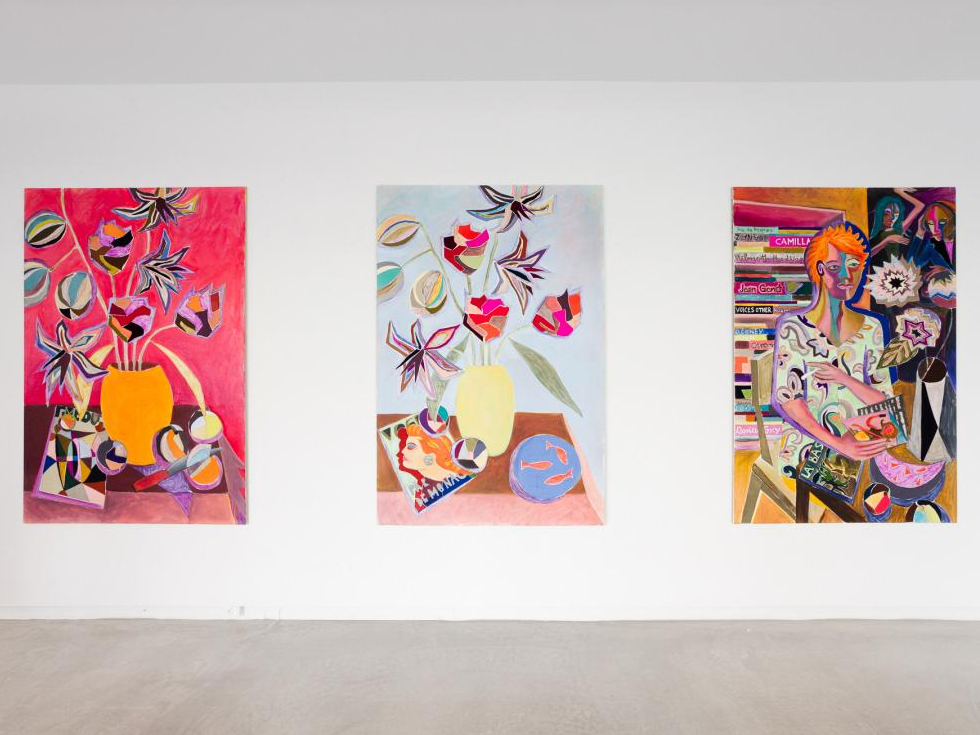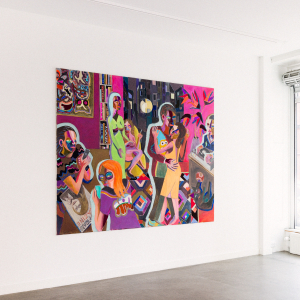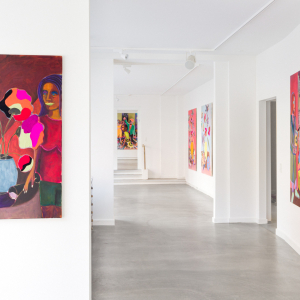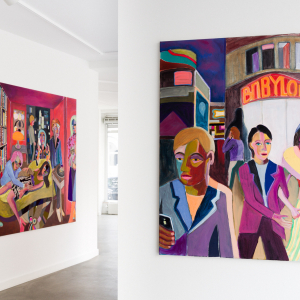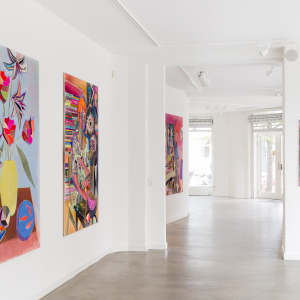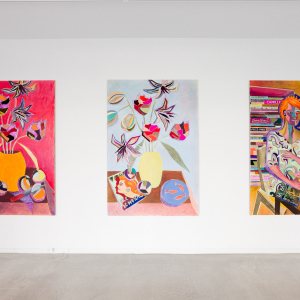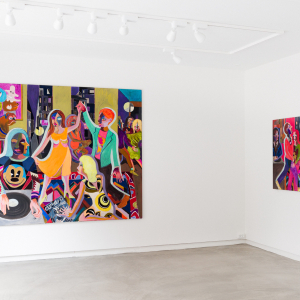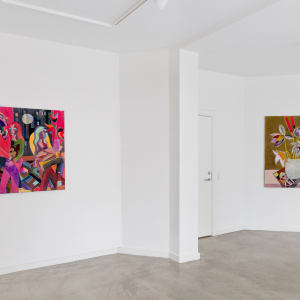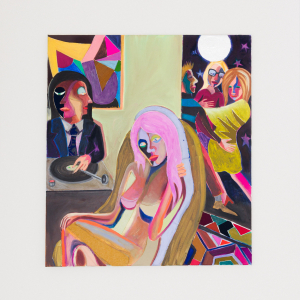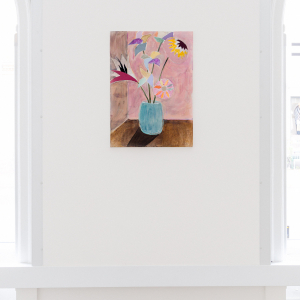Friday September 22, Hans Alf Gallery invites everyone to join the opening of Armin Boehm's solo exhibition "Die hellen Tage".
In his newest series of works, Armin Boehm reflects on the loss of his sister and tries to evoke key moments in their shared life in a series of complex, colorful and luminous paintings that make way for both hope and despair. At the center of the exhibition are the three large-format paintings “Le Spectre de la Rose”, “Les Jours Lumineux” and “Intellectual Séance in Red” that were all created in 2023 and in the wake of a great loss.
In “Le Spectre de la Rose”, we find ourselves in the spacious living room of what seems to be a metropolitan apartment, judging by the architecture visible through the window. A couple is dancing passionately to the music of a DJ in the right of the picture. Two women in the background are quietly observing the dancers, while a couple on the left are absorbed by their smartphones. A cat hangs upside-down mid-air. The scene is familiar yet strangely surreal. The color scheme is complex, but somehow still holds together. We see books on Matisse, Twombly, Duchamps; a carpet paying homage to textile artist Christoph Hefti; flower compositions, fabric patterns, references to mainstream culture, and the aforementioned cat – all recurring pictorial elements in Boehm’s production. Thus, the artist also refers to himself and his own life. And ultimately, what these symbols channel is the theme of urban bohemianism: eroticism, decadence, club culture, fashion, design, the art world itself, architecture, loneliness, disinterest, intrigues, cynicism, arrogance, envy, and jealousy. It’s a psychological portrait of a cultural class.
“Les Jours Lumineux” alludes to the same kind of topics, but it differs from “Le Spectre de la Rose” in the sense that it refers to a specific, private memory of the artist. The scene is a wedding or maybe an engagement party. Boehm is intentionally ambiguous in this regard. The painting itself is not meant as a literal depiction of an historic event, but rather as a representation of a rare, untroubled moment in a life full of hardship. And yet not everything is pure bliss, as suggested by the Janus-headed DJ flirting with a girl while flipping records, the people dancing alone and in a different room in the background – and to different music? – the curled-up girl in a chair staring aloofly at her smartphone, the frowning dog on the bookshelf, and, perhaps most of all, by the ominous countenance of the devil on the cover of a magazine dumped on the floor in front of the dancing couple. Nothing is ever picture-perfect – especially not pictures – and we sense the same underlying themes of indifference, jealousy, and decadence as in “Le Spectre de la Rose”.
Indoor séances – often with an almost occult air to them – have always been a staple of Armin Boehm’s work. In “Intellectual Séance in Red”, we see a girl stretched-out on a chaise lounge, seemingly unwell or in pain. A solemn dog lies on top of her, while a kneeling figure offers her comfort. People are scattered around the room: A woman in the foreground is holding a cat, while a dapper DJ in loafers provides the music with his eyes closed. In the background, a man has stepped out onto the balcony – perhaps to smoke – and a woman is busy talking on the phone. On the left, observing the reclining figure, a man in a painter’s jacket is smoking a cigarette while holding up George Orwell’s “1984”. We see references to Hilma af Klint, Steiner, Fellini, Italian parapsychologist Gutavo Rol, and Christoph Hefti again. The space is more intimate and condensed than in the other paintings – almost claustrophobic – and the feeling of urgency and reverence is tangible. A ritual unfolds. The theme is one of healing: The healing power of music, of animal presence, of conversation, of intimacy, of therapeutic colors. But we also sense that healing is not guaranteed.
In addition to the large, narrative paintings depicted here, “Die hellen Tage” will present a series of medium-sized and smaller paintings that all somehow revolve around the same themes of life, death, decadence, jealousy, joy, and sorrow. In short, the complexity of the human experience.
Armin Boehm (b. 1972, Aachen) was born and raised in southwest Germany. Today, he lives and works in Berlin. Boehm attended the academy in Düsseldorf, where he was the protégé of Jörg Immendorff. He is represented internationally by Meyer-Riegger (Berlin and Karlsruhe), Peter Kilchmann (Zürich), Francesca Minini (Milano) and Choi & Choi Gallery (Seoul). Boehm has had solo exhibitions with prominent galleries such as Tang Gallery, Leo Gallery (both China), and Susanne Vielmetter (Los Angeles). In August 2023 he was awarded the prestigious, newly established Tiemann Prize of 50.000 € for excellence in painting.
As a painter, Boehm has a unique style and touch that make his images instantly identifiable. Boehm almost always incorporates paper and textile patches in his works as a tactile reminder of the many layers of meaning in any image. As Boehm himself puts it, he “likes to paint with a pair of scissors”. This technique serves to emphasize the constructed nature of the painting, and because of the unusual texture of the canvas, strangely recognizable but still not entirely familiar, the viewer is forced to reexamine the work and second-guess his first impression. It is a way of provoking the eye and impeding automatic cognitive reactions.
As an artist, Armin Boehm is both part of society and someone situated on the outside looking in; he is simultaneously the elegant Berlin dandy, who is often pictured lounging in the periphery of his own motives, and the perspicacious and sarcastic polemicist, who calmly registers and dissects from a distance. Whatever his subject may be – innocuous cityscapes, riots from the suburbs, surreal portraits, decadent champagne parlors or flower still lives – Boehm playfully and freely makes use of the past and the present, of the humorous and the tragic, the beautiful and the monstrous, of the political and the naïve. In his often rather epic paintings, he moreover demonstrates his abilities as a sardonic storyteller, who always allows for at least two contradictory readings of the same scenario.
"Die hellen Tage" opens September 22 and will be on view through October 21.
